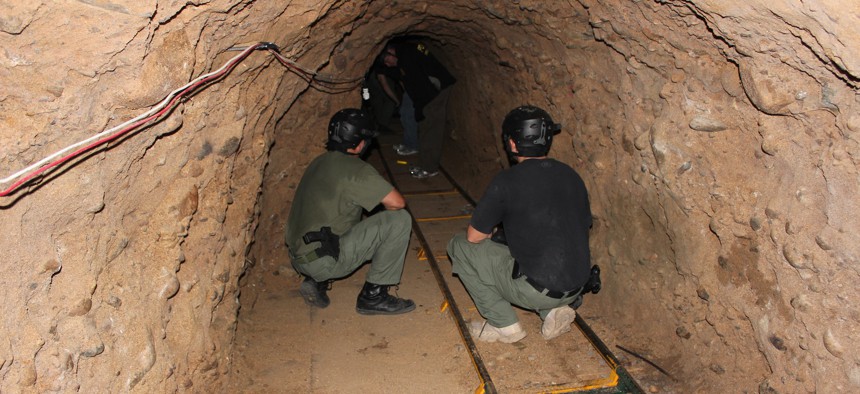
Otay Drug Tunnel. Wikipedia
Border Patrol Wants Robots that Can Go Underground and Report Back
Homeland Security is looking for innovative robots that can navigate underground tunnels and communicate with headquarters.
Customs and Border Protection uses technology to scan faces, probe vehiclesand keep a watchful eye on the border from the skies above. The agency—with help from Homeland Security’s Science and Technology Directorate—also is looking to send robots into underground tunnels and other places where its sensors can’t communicate.
The Science and Technology Directorate released a request for informationMonday to get a sense of the market for robotic communications technology. Specifically, the agency is looking for off-the-shelf tech that can capture and transmit data—including photos and video—and map hard to reach places.
“DHS S&T is interested in evaluating robotic communication capabilities to characterize underground structures, contents, threats and obstacles along the U.S. southern border,” according to the RFI. “These environments range in size and shape, but are all characterized by lack of GPS-signal, short distance—less than 50 meters—line of sight, and a variety of building materials.”
The agency is looking for solutions that can cover 14 technical areas:
- Autonomous navigation in known and unknown environments.
- Robot-to-robot communications in close proximity and over larger distance (1 mile).
- Navigation and localization in GPS-absent environments.
- Virtual/augmented reality robot control interfaces.
- Robotic mobility across multiple surfaces.
- Robotic situational assessment—environment characterization, localization, mission intent.
- Mapping, modeling and visualization of the operating environment.
- Near-real time object recognition in video and still images.
- Non-line of sight, low latency, continuous communications in a constrained environment.
- Robotic package delivery and retrieval.
- Command and control communications in GPS-absent environments.
- Human-robot teaming in near proximity (<10 feet).
- Video streaming in intermittent communication conditions.
- Two-way voice, data and video communications in an underground environment with no existing infrastructure.
While funding will be provided to advance the technologies, officials are looking for solutions that are past the development stage and ready for field trials.
Related: ‘Underground’ May Be the U.S. Military’s Next Warfighting Domain
Related: DARPA Wants to Make Underground Maps on the Fly
Related: Was That a Small Nuclear Test…or Just a Football Game?
The agency plans to hold a demonstration and evaluation exercise August 5-10 in Arizona. Invites to the event will be sent based on responses to the RFI, which are due by 5 p.m. July 17. Contracting officers will be accepting questions through 5 p.m. July 10.
Based on performances during the demo session, Homeland Security expects to award cooperative research and development agreements, or CRADAs.
